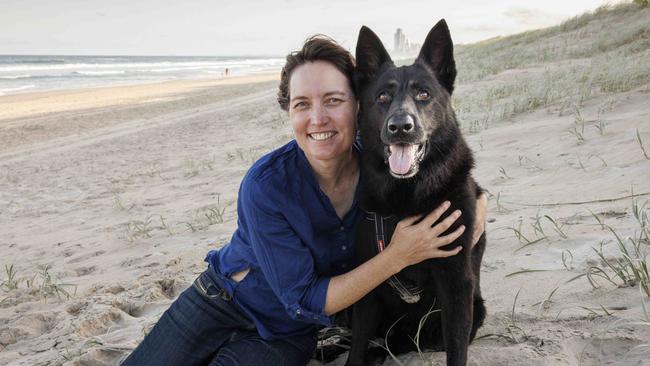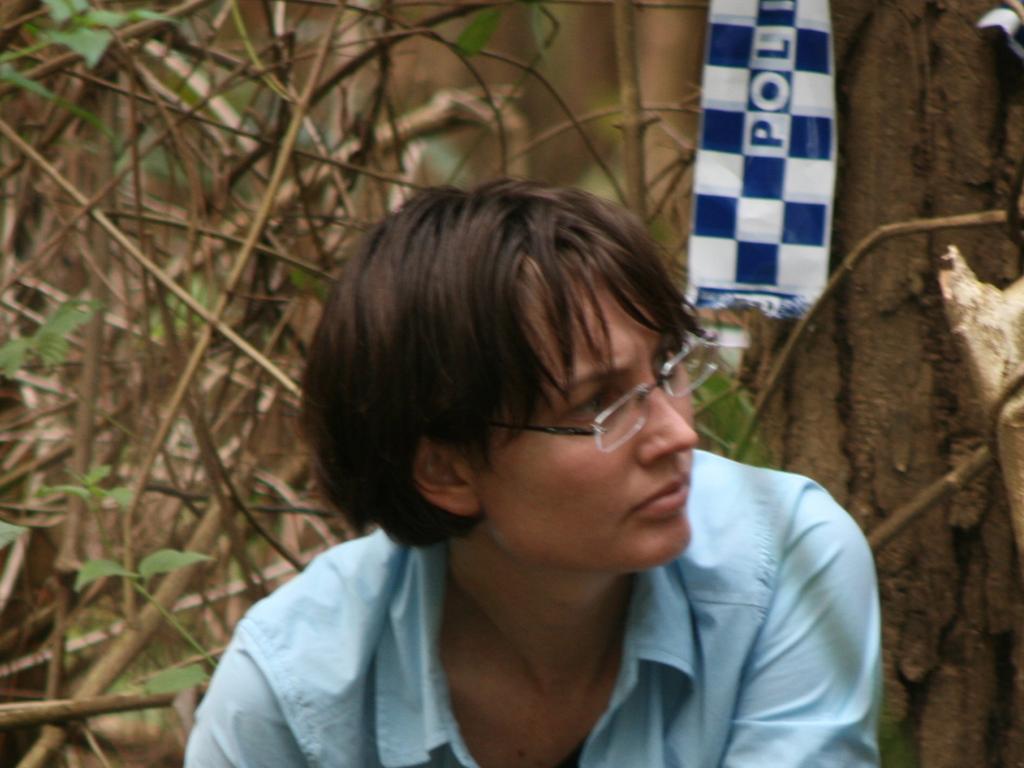Honouring forensic scientist Kirsty Wright who bravely took a stand
Kirsty Wright, who risked her career, her reputation and financial security to help uncover glaring failures at the Queensland government forensics laboratory, is our Australian of the Year.

When they came for Kirsty Wright, they came with teeth bared. The quietly spoken forensic scientist was called all manner of things she had never for a moment imagined herself to be: a turncoat, a tattletale, naive, dangerous.
But she didn’t flinch from doing the right thing then, and she doesn’t resile from it now that the dust has settled on the greatest scandal to engulf Australian forensic science and her central role in exposing it through this masthead.
Dr Wright risked her career, her reputation and financial security to work hand-in-glove with a team led by The Australian’s Hedley Thomas to uncover glaring failures at the Queensland government forensics laboratory that potentially allowed killers and rapists to escape justice.
Her courage and steely commitment to the truth are recognised in her naming as The Australian’s 2022 Australian of the Year.
Speaking from her Gold Coast home, the unassuming 46-year-old said: “I see this as recognition of the importance of speaking out and doing the right thing. You don’t have to be someone famous or someone special to do the right thing. I was just a normal person who found myself in a situation, with the skills I have, that I had an opportunity to really make some change and really help people.”
What began as an investigation by Thomas into the unsolved 2013 murder of north Queensland woman Shandee Blackburn lifted the lid on industrial-scale “scientific vandalism” that sabotaged DNA evidence for years and paved the way for a royal commission-style inquiry to vindicate his work with Dr Wright.
In a scathing report last month, former Queensland Court of Appeal president Walter Sofronoff KC found victims of crime and the police were betrayed by “grave maladministration involving dishonesty” at the state forensics laboratory. Crime scene samples rich in DNA had been written off as having no evidentiary value, the retired judge said. He recommended the review of thousands of major crime cases reaching back more than a decade. Scientist in charge Cathie Allen had repeatedly lied and the cover-up was “about as big as it gets”.

Yet without Dr Wright, none of this would have come to light, editor-in-chief Michelle Gunn said in announcing our Australian of the Year. Worse still, violent criminals guilty of horrific offences could have continued to walk free.
“Dr Wright was a standout for this year’s award, favoured by both our readers and our senior editorial team,” Gunn said. “This is because she embodies values we all aspire to: honesty, integrity, and a determination to change things for the better.”
Dr Wright said the DNA debacle was the worst to rock Australia’s tight-knit forensic science community, surpassing the wrongful conviction of Lindy Chamberlain in 1982 for the murder at Uluru of her baby daughter, Azaria, on the basis of flawed scientific evidence.
As with the Chamberlain case, the abuses of process at the Queensland forensic lab should herald a shake-up in forensic testing centres nationwide, Dr Wright said.
The response from most of her peers and all the professional bodies? “Complete silence, deafening silence,” she said.
Not a peep from the National Association of Testing Authorities (NATA), which accredits forensics labs, nor an inquiring email or text from the Australian and New Zealand Forensic Science Society. Nothing from the National Institute of Forensic Science, either.
“They’re the three main forensic groups in Australia and not one of them has contacted me to ask either for clarification or more detail,” Dr Wright said. “What I was saying wasn’t just affecting Queensland; it was highlighting that there’s a critical gap in our national forensic science quality framework.


“The Queensland forensics lab was NATA-accredited. And if one lab is behaving like that, then it means other labs could also be behaving like that. So it’s extremely disappointing that there has been this radio silence.
She shouldn’t be surprised, though, given the obstacles she faced after being approached by Thomas in 2021 for help to research his Walkley-award winning podcast, Shandee’s Story.
The Australian’s national chief correspondent was trying to make sense of why blood and other samples collected at the murder scene in Mackay returned findings of “no DNA detected” when tested. How could that be when they had to be teeming with genetic markers?
Dr Wright was immediately intrigued. She had worked at the Brisbane laboratory for seven years until 2007, when a “bullying culture” imported with a change of management caused her to leave. But she respected many of the people who were still there, and they deserved the benefit of the doubt.
“I didn’t want to raise alarm bells, at least externally to begin with, because I knew that I really needed to check this out,” she said. “If I was wrong, that would be incredibly damaging to the Blackburns, to other victims of crime, and to the lab as well.”
A few nights later, with the rugby league telecast playing in the background at home, she was reading through a batch of documents and transcripts Thomas had put on a thumb drive when it clicked: the DNA profiling had to be off.
In this type of situation, it’s not unusual for someone like Dr Wright to take a step back in their dealings with an investigative journalist. Yes, I’ll assist. Just keep my name out of the story. In the trade, it’s called backgrounding.
By now, she was employed by the army as a senior forensic scientist, and that could have made things tricky for her. But from the outset she was determined to be on the record, come what may.
“If I was going to come out and make such serious claims and important claims, I wanted to own those claims,” she said.
“I think they’re much more legitimate if they come from a known source.”
Dr Wright secured clearance from her bosses to work with Thomas in her own time, and it soon became apparent that the mishandling of the Shandee crime scene samples was no anomaly.
The lab had introduced higher thresholds for DNA testing, evidently to save time and money, and the police weren’t awake to the implications. Samples that fell below the new limit were immediately written off as containing no DNA when, in fact, some 10 per cent of them could have generated an actionable genetic profile.
Dr Wright didn’t voice her concerns only through Thomas’s top-rating podcast and the masthead’s follow-up coverage; she shouted them into every microphone put her way. The official response was dismally predictable: shoot the messenger.
Mr Sofronoff documented a series of meetings involving senior managers to devise a strategy to go after Dr Wright.
“Action items” included approaching the Queensland University of Technology, where she is a visiting fellow, to discredit her. Legal action was flagged over an alleged violation of the Queensland Health code of conduct, even though she hadn’t worked for the department for years; a lab manager contacted the Australian Criminal Intelligence Commission “to dig up dirt”, she said.
“I knew that I was risking my career, my reputation, my financial security and maybe even my safety,” she recalled.
“So it was really like taking a leap into the unknown – I didn’t know where I was going to end up.
“But there was no way after finding out what Hedley and I found out that we were going to stay quiet.”
Applauding Dr Wright’s principled decision to put the “public good” first, Mr Sofronoff wrote in his December 13 report: “In my opinion, her willingness to take a public stand was an act of real bravery.”
The full consequences for Ms Allen – facing the sack after being branded a “malignancy” by the commissioner – and at least two other adversely mentioned managers are yet to play out.
Ms Allen strenuously denies wrongdoing.
A key recommendation from the inquiry was to put the troubled forensic lab under a stand-alone agency, independent of state control. Dr Wright considers that to be a good start. She has recharged and reset over Christmas, enjoying sorely needed time on the beach with her inky Alsatian, Ava, and catch-ups with family and friends.
She will be watching what happens next in Queensland to implement the Sofronoff findings and in other jurisdictions, too, because the DNA testing scandal must never, ever be repeated. The message to her critics and peers alike is she is not going away.
“I call bullshit,” Dr Wright said of the forensic science community’s so-far muted response.
“I’m hoping I don’t have another battle on my hands. But if that is genuinely their position – to basically ignore what happened and hope it doesn’t happen again – then I’m going to step into the batter’s box for another round.”
NATA, the Australian and New Zealand Forensic Science Society and National Institute of Forensic Science were contacted for comment.






To join the conversation, please log in. Don't have an account? Register
Join the conversation, you are commenting as Logout